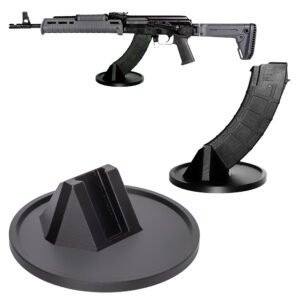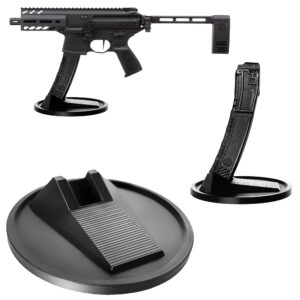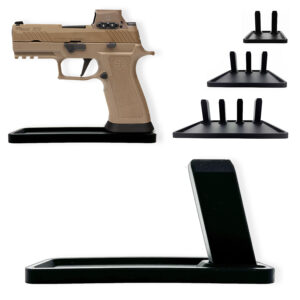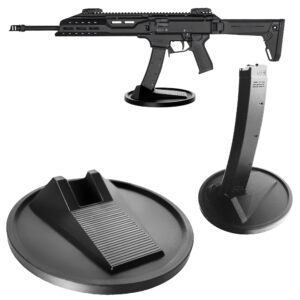
Categories:
The AR10 Buttstock is a fundamental component that significantly influences the performance, comfort, and handling of the AR10 rifle. Known for its powerful capabilities and robust design, the AR10 is a favored choice among shooting enthusiasts, law enforcement, and military personnel. The buttstock, often an overlooked aspect, plays a critical role in not only supporting the rifle against the shoulder but also in housing the buffer tube—a key element in the gun’s operating system.
At its core, the primary function of the AR10 buttstock is to provide stability and support when firing, ensuring that the full recoil is effectively absorbed and distributed across the shoulder. This not only enhances accuracy but also minimizes user fatigue, particularly during prolonged shooting sessions. The ergonomic design of most modern buttstocks is tailored to fit comfortably against the shoulder, lined with padding or contoured materials to improve the shooter’s experience.
Furthermore, the AR10 buttstock houses the buffer tube, an essential component that impacts the rifle’s cycling process. The buffer tube contains the buffer and recoil spring, which serve to dampen the recoil generated upon firing. This action reduces the felt recoil, speeds up the reset for follow-up shots, and enhances overall weapon control. The integration of the buffer system within the buttstock also facilitates smoother operation by stabilizing the bolt carrier group and ensuring reliable feeding and ejection of cartridges.
In addition to its functional significance, the design and material of the buttstock can affect the rifle’s overall weight and balance. Lightweight materials like polymer or carbon fiber are commonly used to craft buttstocks that do not sacrifice durability for weight. Adjustable buttstocks offer further customization, allowing users to modify length of pull to suit different shooting stances or body sizes.
Features such as cheek risers and sling attachment points add to the rifle’s adaptability and comfort.
Ultimately, the AR10 buttstock is much more than a simple support mechanism. It is a complex and vital part of the rifle’s assembly that contributes to performance, reliability, and user comfort. Understanding its multiple roles and functionalities can greatly enhance an AR10 owner’s appreciation and effective utilization of their gun. Whether one is a seasoned shooter or a newcomer, recognizing the importance of the buttstock ensures better maintenance, customization, and overall shooting experience.
The buttstock of an AR-10 is an essential component that significantly contributes to the rifle’s overall effectiveness, functionality, and user comfort. At its core, the buttstock supports the rifle against the shooter’s shoulder, ensuring stability and control during firing. This stability is particularly crucial when handling the substantial power and recoil generated by the AR-10’s larger caliber rounds. A well-designed buttstock helps distribute the recoil more evenly across the shoulder, reducing the shock felt by the shooter and allowing for more accurate follow-up shots.
In addition to providing stability, the buttstock serves as the housing for the buffer tube, a critical element in the proper operation of the AR-10. The buffer tube, often referred to as the receiver extension, contains the buffer and buffer spring. These components play a vital role in the rifle’s cycling process, absorbing and redirecting the energy generated by firing a round to reset the bolt carrier group for the subsequent shot.
Without a properly functioning buffer system housed within a sturdy buttstock, the rifle could experience malfunctions, increased wear on internal parts, and potential damage to the receiver.
User comfort is another significant factor influenced by the design and quality of the buttstock. An adjustable buttstock, for instance, allows for length of pull modifications, enabling shooters of various sizes to customize the rifle to their body type and shooting style. This adaptability ensures that individuals can maintain a comfortable and stable shooting position, which is critical for accuracy and endurance, especially during extended shooting sessions or in dynamic shooting environments.
Moreover, modern buttstocks often incorporate additional features designed to enhance overall functionality. Some buttstocks come equipped with built-in storage compartments for small tools, spare batteries, or cleaning supplies, ensuring that essential accessories are readily accessible. Others feature cheek risers, which provide a consistent and ergonomic cheek weld, essential for maintaining a proper sight picture and improving aiming precision.
In summary, the buttstock of the AR-10 is a multifaceted component that supports the rifle against the shoulder, houses the buffer tube, and significantly contributes to the comfort, stability, and overall effectiveness of the rifle. A well-designed buttstock not only enhances the rifle’s performance but also ensures that shooters can operate their AR-10 with greater control and efficiency, making it an indispensable part of the gun.
The design and construction of AR10 buttstocks play a pivotal role in the overall functionality and ergonomics of the rifle. These components are engineered to provide support against the shoulder, ensuring stability and comfort during firing, while also housing the buffer tube, which is crucial for the rifle’s recoil management system. The interplay between these two functions demands a meticulous approach to both design and material selection.
In terms of design, AR10 buttstocks are crafted to balance robustness with ergonomic comfort. The contour and length of the buttstock are ergonomically shaped to fit securely against the shoulder, reducing shooter fatigue and enhancing accuracy. Adjustable buttstocks are particularly popular as they allow for customization to fit the individual shooter’s body type and shooting stance. This adjustability is typically achieved through a telescoping mechanism, which allows the user to extend or retract the buttstock to the desired length of pull.
Some advanced models also feature adjustable cheek rests and butt pads, further enhancing shooter comfort and control.
The construction materials for AR10 buttstocks vary but commonly include high-strength polymers, aluminum, and sometimes composite materials. High-strength polymers are favored for their durability and lightweight properties, making them ideal for extended use in diverse conditions. Aluminum is often incorporated into the design where additional strength is required, particularly in the mounting hardware and adjustment mechanisms. Composite materials, combining the best properties of both polymers and metals, are increasingly used to create buttstocks that are both strong and lightweight.
Housing the buffer tube is another critical function of the AR10 buttstock. The buffer tube, also known as the receiver extension, contains the recoil spring and buffer, which are essential components for absorbing and dissipating recoil energy. The integrity of the buffer housing is vital, as any weakness can compromise the rifle’s recoil management and overall performance. Therefore, the connection point between the buttstock and the receiver is reinforced to handle the stress imparted during firing.
Manufacturers often incorporate innovative features to enhance the utility of their buttstocks. For instance, some designs include storage compartments for small tools or batteries, while others integrate sling attachment points to facilitate easier carrying of the rifle. The surface texture of the buttstock is another consideration, with non-slip patterns often molded into the polymer surface to provide a better grip.
Overall, the design and construction of AR10 buttstocks reflect a comprehensive approach to meeting the demands of functionality, comfort, and durability, ensuring that the rifle performs optimally in various shooting scenarios.
The buttstock of an AR-10 rifle serves as a crucial component in gun design, providing essential support against the shoulder during operation. When a shooter places the buttstock firmly against their shoulder, it creates a stable platform that significantly enhances accuracy and control. This stability is particularly important during rapid fire or while shooting at distant targets. The buttstock’s design distributes the recoil’s force more evenly across the shooter’s shoulder, reducing felt recoil and allowing for quicker follow-up shots.
The ergonomic shape of the buttstock conforms to the shoulder’s contour, ensuring a snug fit. This tight fit is vital as it minimizes movement and slippage during firing, which could otherwise result in a less predictable shot placement. Additionally, many buttstocks are adjustable, allowing shooters to customize the length of pull. This adjustability ensures that shooters of varying sizes and body types can achieve a comfortable and efficient shooting stance.
By adjusting the length, shooters can maintain a proper cheek weld, which is the consistent point of contact between the shooter’s cheek and the stock. This is crucial for aligning the eye with the sight and achieving consistent accuracy.
Moreover, the buttstock’s construction materials also play a part in its functionality. Many modern AR-10 buttstocks are made from high-strength polymers or lightweight metals, providing a balance of weight and durability. This construction not only aids in the overall maneuverability of the rifle but also in absorbing and mitigating the impact of recoil forces. A well-designed buttstock with the appropriate padding or recoil-reducing features can significantly improve the shooting experience by reducing the shock that travels through the gun and into the shoulder.
Furthermore, the buttstock houses the buffer tube, an integral part of the rifle’s recoil management system. The buffer tube contains the buffer spring and buffer, which work together to absorb and dissipate the energy generated when firing a round. This mechanism helps to cycle the bolt carrier group, ensuring reliable operation and reducing wear on internal components. The synergy between the buttstock and buffer tube is essential for maintaining the rifle’s accuracy and longevity.
In essence, the AR-10 buttstock is not merely a physical attachment but a sophisticated component that enhances the interface between the shooter and the rifle. Through its ergonomic design, adjustability, and integral role in housing the buffer tube, the buttstock ensures that the shooter can maintain control, precision, and comfort in various shooting scenarios.
In the design and function of an AR10 rifle, the buttstock is a critical component that supports the rifle against the shooter’s shoulder, providing stability and control. Integral to the buttstock is the buffer tube, a cylindrical piece that plays a significant role in the rifle’s performance, ensuring the AR10 operates efficiently and reliably.
The buffer tube, also referred to as the receiver extension, extends from the rear of the receiver and houses the buffer and buffer spring. These parts work together as part of the rifle’s recoil management system. When a shot is fired, the high-pressure gases from the ignited gunpowder force the bolt carrier group backward. This movement compresses the buffer spring and drives the buffer into the buffer tube.
The compressed spring then exerts force to push the buffer and bolt carrier group forward, chambering the next round. This cycle, facilitated by the buffer tube, is essential for the semi-automatic function of the AR10, allowing for successive shots without manual intervention.
Moreover, the buffer tube’s design and material construction contribute to the overall balance and ergonomics of the rifle. Typically made from lightweight and durable materials such as aluminum, the buffer tube must withstand significant forces during operation. Precision engineering ensures that the tube’s internal dimensions are optimal for the smooth and consistent movement of the buffer and spring, which is critical for maintaining the rifle’s accuracy and reliability.
The length and diameter of the buffer tube can also influence the rifle’s performance. For instance, a rifle-length buffer tube contains a longer buffer and spring, which can mitigate recoil more effectively than shorter configurations. However, shorter carbine-length buffer tubes offer greater compatibility with adjustable buttstocks, allowing the shooter to modify the length of pull for improved comfort and maneuverability in various shooting scenarios.
In essence, the buffer tube serves multiple roles within the AR10 buttstock framework. It functions as a critical component in the recoil management system, ensuring the smooth operation of the rifle. Additionally, it contributes to the weapon’s balance and overall handling, influencing the shooter’s effectiveness and comfort. The design and specification of the buffer tube, therefore, have a direct impact on the AR10’s performance, making it a key element to consider for any AR10 enthusiast or operator seeking optimal functionality from their rifle.
The AR10 rifle is renowned for its versatility and robustness, and one of its key components is the buttstock. The buttstock plays a crucial role by supporting the rifle against the shoulder and housing the buffer tube, which is essential for the rifle’s operation. There are various types of AR10 buttstocks available, each designed to meet specific needs and preferences of shooters.
One popular type is the fixed buttstock. This traditional design is known for its durability and stability. Fixed buttstocks do not have any moving parts, making them less susceptible to damage and easier to maintain. They are a preferred choice for marksmen who prioritize accuracy and a stable shooting platform. These buttstocks are commonly made from high-strength materials like polymer or fiberglass, which contribute to their long-lasting performance.
Another widely used type is the collapsible or adjustable buttstock. This variant offers greater flexibility in terms of length of pull, allowing shooters to customize the fit of the rifle to their body type or shooting style. Collapsible buttstocks are particularly advantageous for tactical and close quarters situations where quick adjustments can enhance maneuverability. They often feature multiple positions that can be easily changed, providing adaptability for different shooting scenarios.
For those seeking a blend of stability and adaptability, the precision adjustable buttstock is an ideal choice. These buttstocks combine elements of both fixed and collapsible designs, offering a solid base with adjustable cheek rests and length of pull. Precision adjustable buttstocks are favored by competitive shooters and precision rifle enthusiasts who require fine-tuned adjustments for optimal comfort and accuracy.
In addition to these primary categories, there are specialized buttstocks such as the minimalist or skeletonized buttstocks. These designs prioritize weight reduction and streamlined profiles, making them suitable for lightweight builds and high-speed shooting disciplines. Despite their minimalistic construction, they still provide sufficient support and stability for effective shooting.
Each type of AR10 buttstock brings its own unique features and benefits to the table. The choice largely depends on the individual’s shooting needs, preferences, and specific use cases. Whether one prioritizes stability, adaptability, or weight savings, there is an AR10 buttstock designed to enhance the overall performance and user experience of the rifle. Consequently, understanding the distinct features of each type allows shooters to make informed decisions, ensuring their AR10 is perfectly suited to their requirements.
Installing and maintaining an AR10 buttstock is a crucial aspect of ensuring your rifle functions optimally and remains comfortable during use. The AR10 buttstock serves two primary purposes; it supports the rifle against your shoulder and houses the buffer tube, which is essential for the rifle’s recoil management and cycling system. Understanding how to properly install and care for this component is vital for any AR10 owner.
To install an AR10 buttstock, begin by ensuring your rifle is unloaded and cleared of any ammunition to avoid accidental discharge. Start by removing the old buttstock if one is already attached. This usually involves loosening and removing the screw or pin that secures the buttstock to the buffer tube. Once the old buttstock is removed, inspect the buffer tube for any wear or damage; it should be clean and free of debris.
Next, align the new buttstock with the buffer tube. Slide the buttstock onto the buffer tube until it reaches the desired position. Different types of buttstocks may have varying methods of attachment, so refer to the manufacturer’s instructions for specific details. Typically, this will involve securing the buttstock with a screw or locking pin, ensuring it is tightly fastened to prevent any wobble during use.
For adjustable buttstocks, test the adjustments to ensure they move smoothly and lock into place securely. Once installed, perform a function check on your rifle to ensure everything operates correctly. It’s crucial that the buttstock is firmly attached, providing a stable platform for shooting and proper housing for the buffer tube.
Maintenance of the AR10 buttstock involves regular inspection and cleaning. Frequently check the buttstock for any signs of damage or wear, especially after extensive use. Ensure all screws and pins are secure and not loosened. Keep the buffer tube and spring clean; dirt and grime can affect the rifle’s performance. Apply a light coat of lubricant to metal components to prevent rust and corrosion, but avoid over-lubricating as this can attract debris.
Remember to always follow safety protocols when performing maintenance. A well-maintained buttstock ensures better recoil management, accurate shooting, and a longer lifespan for your rifle. Adhering to proper installation and maintenance procedures will greatly enhance the reliability and comfort of your AR10, leading to an improved overall shooting experience.








Colt
Colt M4 Carbine
Colt LE6920
Colt AR-15 A4
Daniel Defense
DDM4 V7
DDM4 V9
DDM4 V11
DDM4 ISR (Integrally Suppressed Rifle)
Smith & Wesson (S&W)
M&P15 Sport II
M&P15 Tactical
M&P15T
Bravo Company Manufacturing (BCM)
BCM Recce-16
BCM Recce-14
BCM MCMR Series
Aero Precision
M4E1 Series
AC-15
AR15 Pistol (Various Configurations)
Ruger
Ruger AR-556
Ruger SR-556
Ruger AR-556 MPR (Multi-Purpose Rifle)
Springfield Armory
Saint Victor
Saint Edge
Saint AR-15
PSA (Palmetto State Armory)
PSA PA-15
PSA AR-V
PSA Jakl (AR Pistol)
FN America
FN 15 Tactical Carbine
FN 15 Patrol
FN 15 DMR
Wilson Combat
Recon Tactical
Super Sniper
Protector Carbine
SIG Sauer
SIG M400 Tread
SIG M400 Elite
SIG M400 SDI
LWRC International
IC DI (Direct Impingement)
IC SPR
IC A5
Bushmaster Guns
XM-15 QRC
Bushmaster MOE
XM-15 Patrolman
Rock River Arms
LAR-15 Entry Tactical
LAR-15 Predator
LAR-15 Elite Comp
Stag Arms
Stag 15 Tactical
Stag 15L (Left-Handed Models)
Stag 15 Valkyrie
Noveske Rifleworks
Noveske Gen 4 N4
Noveske Space Invader (AR Pistol)
Noveske Recon
Anderson Manufacturing
AM-15 Optic Ready
AM-15 M4 Carbine
AM-15 Precision Rifle
Adams Arms
AA-15 Piston Rifle
P2 AARS (Adams Arms Rifle Series)
Black Rain Ordnance
SPEC15 Series
BRO Predator
Fallout 15
Diamondback Guns
DB15 Series
DB15CCMLB
DB15EB
Del-Ton Inc.
DTI-15
Del-Ton Echo 316H
Sierra 316M
Windham Weaponry
Windham SRC
Windham VEX-SS
Windham RMCS-4 (Caliber Conversion System)
Christensen Arms
CA-15 G2
CA-15 Recon
CA-15 Titanium Edition
Patriot Ordnance Factory (POF-USA)
Renegade Plus
P415 Edge
Revolution DI
LaRue Tactical
PredatAR
OBR (Optimized Battle Rifle)
LaRue Stealth 2.0
Battle Arms Development
Workhorse Patrol Carbine
BAD556-LW (Lightweight)
Authority Elite Rifle
Faxon Guns
Ascent AR-15
FX-19 (AR Pistol)
Streamline Ultralight Series
KE Arms
KE-15 SLT (Super Lightweight Tactical)
KE-15 Scout Carbine
Primary Weapons Systems (PWS)
MK1 MOD 2-M
MK116 PRO
MK107 (Piston AR Pistol)
ZEV Technologies
ZEV Core Elite Rifle
ZEV AR15 Billet Rifles
Franklin Armory
BFSIII AR-C1
Militia Model
F17-L (Chambered in .17 WSM)
Seekins Precision
SP15 DMR
NX15 Skeletonized Rifle
Havak Bravo
Aero Precision (Additional Models)
EPC-9 (Pistol Caliber ARs)
VG6 AR Rifles
Barrett Guns
REC7 DI
REC7 Gen II
CMMG
MK4 RCE
Resolute 300
Banshee (AR Pistol)
DPMS Panther Arms
Panther Oracle
Panther LR-308
H&K (Heckler & Koch)
HK MR556A1
HK416 (Military Variant)
Rock Island Armory (Armscor)
VR-80 Tactical AR (Shotgun AR Platform)
Troy Industries
Troy SPC-A3
Troy PAR (Pump Action AR)
Wilson Tactical
Tactical Recon AR
Protector Series
F1 Guns
FDR-15 Skeletonized Rifle
BDRx-15 Series
Juggernaut Tactical
JT-15
JT-10 Precision Rifle
AeroSurplus
Surplus AR-15 Rifles (Budget Models)
Thunder Tactical
AR-15 Basic Carbine
Tactical Builder Sets
Radical Guns
RF-15
Forged AR-Series
Dark Storm Industries
DS-15 Featureless Rifles
DS-10 Typhoon
DRD Tactical
Paratus
Aptus AR Rifles
Bear Creek Arsenal
BCA-15
AR Complete Upper Builds
Aero Survival Rifles (ASI)
ASR Tactical Series
Tactical Edge
WARFIGHTER Series
AR-15 Lightweight Rifles
Lone Star Armory
TX15 DMR
TX15 Carbine
HERA Arms
HERA H7
HERA AR-15 Lower Builds
IWI (Israeli Weapon Industries)
Zion-15
DRD Tactical
Tactical Modular Rifles
Quick-Takedown Rifles
V Seven Weapons
1776 Rifle
Hyperlite Rifle
Core Rifle Systems
Core15 Tac III
Core15 Patrol Rifle
Armalite (Original AR-15 Creator)
M15 Tactical
M15 A4 Carbine
DEF15 (Defensive Sporting Rifle Series)
PSA (Palmetto State Armory Additional Models)
PSAK-47 Hybrid (AR-AK Style Hybrid)
PSA Dagger (Pistol Caliber Configurations)
Odin Works
OTR-15
Odin Recon Rifle
Maxim Defense
MDX-508 PDX (Compact AR Pistol)
MDX-510 Rifle